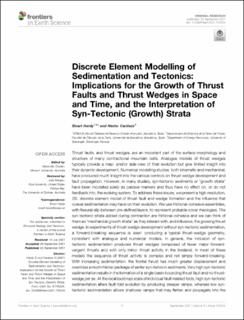| dc.description.abstract | Thrust faults, and thrust wedges, are an important part of the surface morphology and structure of many contractional mountain belts. Analogue models of thrust wedges typically provide a map- and/or side-view of their evolution but give limited insight into their dynamic development. Numerical modelling studies, both kinematic and mechanical, have produced much insight into the various controls on thrust wedge development and fault propagation. However, in many studies, syn-tectonic sediments or “growth strata” have been modelled solely as passive markers and thus have no effect on, or do not feedback into, the evolving system. To address these issues, we present a high-resolution, 2D, discrete element model of thrust fault and wedge formation and the influence that coeval sedimentation may have on their evolution. We use frictional-cohesive assemblies, with flexural-slip between pre-defined layers, to represent probable cover rheologies. The syn-tectonic strata added during contraction are frictional-cohesive and we can think of them as “mechanical growth strata” as they interact with, and influence, the growing thrust wedge. In experiments of thrust wedge development without syn-tectonic sedimentation, a forward-breaking sequence is seen: producing a typical thrust-wedge geometry, consistent with analogue and numerical models. In general, the inclusion of syn-tectonic sedimentation produces thrust wedges composed of fewer major forward-vergent thrusts and with only minor thrust activity in the foreland. In most of these models the sequence of thrust activity is complex and not simply forward-breaking. With increasing sedimentation, the frontal thrust has much greater displacement and overrides a much thicker package of earlier syn-tectonic sediments. Very high syn-tectonic sedimentation results in the formation of a single basin-bounding thrust fault and no thrust-wedge per se. At the local (outcrop) scale of individual fault-related folds, high syn-tectonic sedimentation alters fault-fold evolution by producing steeper ramps, whereas low syn-tectonic sedimentation allows shallower ramps that may flatten and propagate into the syn-tectonic strata. Implications of these results for the interpretation of thrust faults and wedges and their interaction with associated growth strata are discussed. | en_US |

